| On March 17, 2001, a crowd gathered at
Isabella Cemetery to pay tribute to John Hutchison. When he died in
1951, at age 105, he was the last of Missouri's Civil War veterans.
This ceremony marked the 50th anniversary of that time. Civil War
re-enactors came with their muskets and fired a
cannon. |
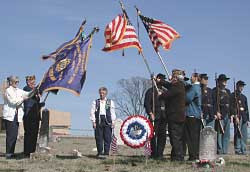 |
There were flags, music, speeches and Civil War uniforms.
Muskets rang out, and a cannon roared. |
| Civil War re-enactors participated in
the ceremony. |
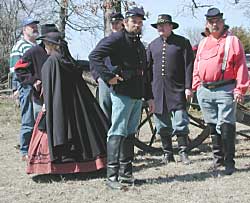 |
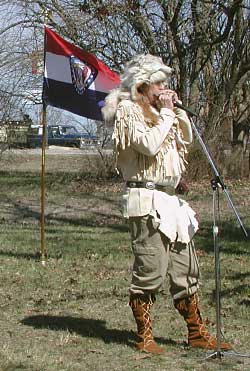 |
First came the music. Dean Knapp played tunes from
Civil War times on a harmonica. |
| The ceremony began with prayers and speeches. Inell
McMillon, organizer of the memorial ceremony, spoke about the war.
She noted that Ozark County lost three quarters of its population
in the Civil War (1861-65). People fled lawless bands of murderous
looters from both sides. Hutchison joined the Union army after he
saw them shoot his uncle. He wanted to help protect people from the
"bushwackers." |
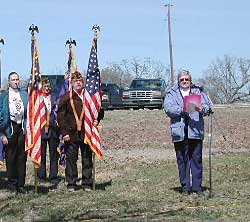 |
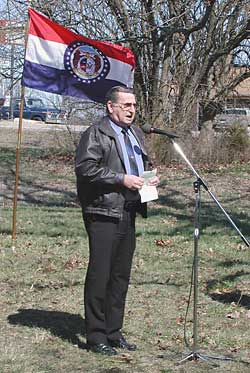 |
Local State Representative, Estel Robirds, spoke a
few words. |
| Members of VFW Post No. 5366 and its Auxiliary from
Isabella stood with flags at the gravesite. |
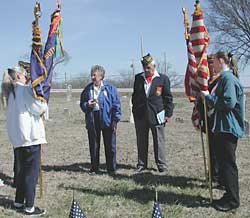 |
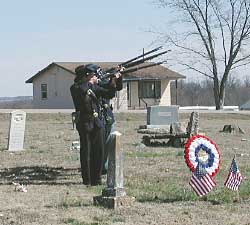 |
Sons of Union Veterans, Phelps Camp #66 from Springfield,
fired a volley near Hutchison's grave. |
| Firing
the Cannon |
| Members of the Second Illinois Light Artillery from
Mountain Home are ready to fire the cannon. They wear Union blue uniforms
here. When they wear Confederate gray, they are known as Wiggins Battery.
On the near side, a soldier holds the "worm," a pole he uses to
clean out the barrel after the cannon fires a shot.
The soldier on the far side of the cannon makes sure there are
no burning embers left in the barrel. He'll shove in a pole with
a wet sponge on the end.
|
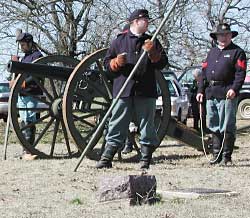 |
| After cleaning, they load the barrel with
a one-pound charge of gunpowder, wrapped in aluminum foil -- no cannonball
today! In Civil War times, the gunpowder would have been pre-wrapped
in a silk bag, sometimes with a cannon ball attached, sometimes not.
A "friction primer" will trigger the explosion. It's a small tube
drilled through the top of the cannon barrel to the gunpowder charge.
First they pierce the bag holding the charge with a piece of brass
called a "prick." This exposes the charge in the barrel to the action
of the "friction primer." Then they pour fine gunpowder into the
friction primer. At its top is a flint that will strike a spark,
igniting the gunpowder in the tube, which sets off the main charge.
|
| To trigger the cannon, a soldier attaches the lanyard
(a strong cord) to the top of the friction primer. He pulls it so
that a flint at the top of the tube makes a spark that ignites the
gunpowder in the tube. Almost instantly, the ignited gunpowder in
the friction primer sets off the main charge in the cannon. |
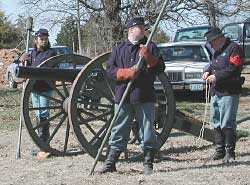 |
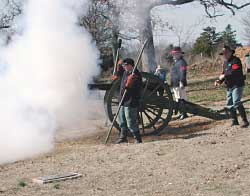 |
Kaboom! The cannon goes off in an ear-splitting bang
and a cloud of smoke. |
| Getting ready for the next shot. One soldier reams
the cannon barrel to clean it out. Then the other will sponge it to
put out any burning embers left in the barrel. |
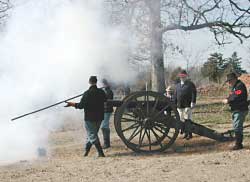 |
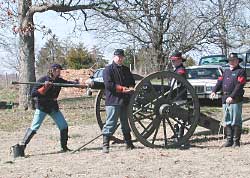 |
Then they reload it with another charge of gunpowder
and tamp it down. |
| A woman dressed in black witnesses the
men with their deadly weapon. |
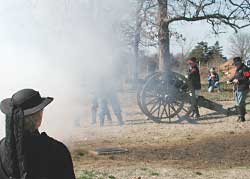 |
"War today is not any
worse or better than it was back in 1864. It's all bad. You wade in
mud and water up to your neck and then, after it's all over, you don't
know why you went."
--John Hutchison |

